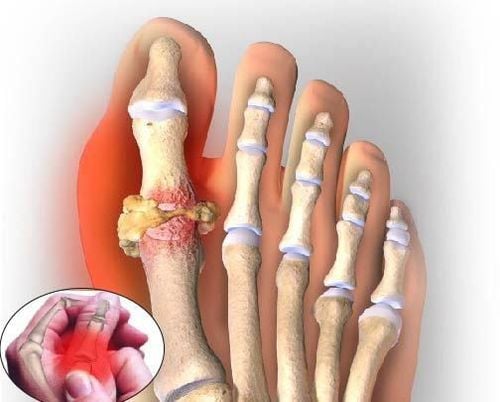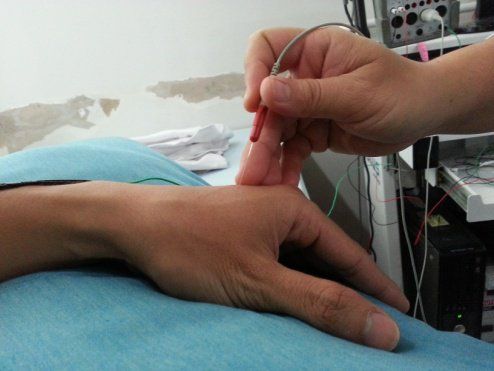This is an automatically translated article.
The article was professionally consulted by MSc Bui Ngoc Phuong Hoa - General Internal Medicine Doctor, Department of Medical Examination & Internal Medicine - Vinmec Danang International General HospitalElectromyography technique was born with the purpose of probing the electrical response of nerves and muscles, assessing the loss of nerve distribution of muscles. In addition, electromyography can also measure motor and sensory conduction velocity and diagnose electrically in peripheral nervous system lesions.
1. Definition of electromechanical recording (EMG)
Electromyography is used to study the electrical responses of nerves and muscles or to evaluate the loss of nerve distribution of muscles. This is a technique commonly used in examination and diagnosis of diseases in modern neurology practice.
The motor neurons transmit electrical signals to the muscle region, in response to the signal received will cause muscle contraction. The electromyography record is a translation of these signals into sounds, graphs, or numerical values that doctors looking at them will read and understand.
The results of the electromyography may show nerve abnormalities or abnormalities in the muscles or conduction of the nerve-muscle contact.

2. Indications and contraindications of electromechanical recording
Indications for implementation:Patients with muscle damage due to nerve or muscle disease such as damage to muscle parenchyma (myopathy, myositis) or other diseases; Indications performed to assist in the diagnosis and monitoring of: Neuromuscular junction disorders caused by myasthenia gravis, myasthenia gravis; Prognosis of nerve damage due to trauma such as: spinal cord injury, nerve injury. Identify the area of local nerve damage or compression (carpal tunnel syndrome, ankle, nerve root compression), neuritis, motor neuron disease,... Electromyography is doctored. Doctors do it when they notice that the patient has signs or symptoms such as:
A stinging sensation in the skin; A feeling of numbness; Muscle weakness, drooping eyelids, difficulty swallowing; Muscle pain or cramps; Some types of pain in the arms or legs. Weak limbs, muscle atrophy,... Contraindications for implementation:
Before performing the procedure, the doctor will ask the patient about the situation of using the drugs the patient is using. Electromyography and nerve conduction velocity studies will not be performed if the patient is taking medication, including anticoagulants such as Warfarin and Heparin.
3. Electromechanical recording for what?
The purpose of electromyography is to probe the peripheral nervous system. The peripheral nervous system is the part of the nervous system located outside the brain and spinal cord. The peripheral nervous system is a collection of nerves, nerve plexuses, and nerve roots. The benefit of performing electromyography will help the doctor to confirm the diagnosis, differentiate the nature of axonal or coordinate lesions, motor neurons, myelin, and diagnose localization and prognosis. to determine the cause of the disease and provide the most effective treatment.
Patients after performing electromyography, the doctor looking at the results can identify some diseases such as:
Nerve disorders outside the spinal cord (peripheral nervous system), such as carpal tunnel syndrome or peripheral neuropathy. Electromyography helps doctors diagnose disease and decide whether surgical treatment is needed; Disorders affecting motor nerves in the brain or spinal cord such as amyotrophic lateral sclerosis or paralysis; Nerve root disorders such as spinal disc herniation, sciatica: assess the surgical stage and which nerve roots should be prioritized for surgery; Muscular disorders such as muscular dystrophy or polymyositis; Diseases that affect the nerve-muscle connection, such as myasthenia gravis.

4. What should the patient prepare before performing electromyography?
Electromyography is a technique with very low risk factors and few complications. However, before performing the technique, the doctor will discuss, perform a clinical examination, do routine tests to determine:Has a pacemaker or any other electrical device in the patient or are not? Is the patient being treated for anemia? Does the patient have hemophilia or a coagulation disorder that causes prolonged bleeding? Prepare the patient before the electromyography:
Clean the patient's hands and feet before conducting the electromyography; Explain to the patient the steps to take, guide the patient to coordinate in the process of electromyography; For children, it is necessary to prepare them mentally in advance, depending on the age, attitude and experience of the child. At Vinmec International General Hospital, electromyography and nerve conduction velocity recording methods are used in diagnosing nerve and muscle abnormalities. This technique is performed by a team of well-trained doctors and nurses in the country as well as internationally, with rich expertise and experience; with the support of modern and advanced equipment; professional medical service quality.
Please dial HOTLINE for more information or register for an appointment HERE. Download MyVinmec app to make appointments faster and to manage your bookings easily.














